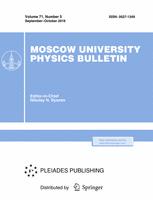On the base of an experimental study of the boundary layer of the head of a dam break flow it is shown that the thickness of a viscous layer exceeds the bottom particle diameter $d_p$, increases with $d_p$, and decreases with the flow velocity (for ${d_p<1.2}$ cm). Bottom particles are captured by satellite eddies, which originate from main eddies near the bottom. Main eddies periodically appear in the viscous layer if the flow decelerates downstream. If ${d_p>0.045}$ cm the satellite diameter is smaller than $d_p$. Satellites close in and run into one eddy, which can contain the bottom particles if the flow velocity achieves a critical value $U_{\rm dip}$. Particles can be captured when the flow velocity has a higher value${U_{\rm cr}>U_{\rm dip}}$. It is possible under this condition that a particle starts to rotate in the satellite without slippage.
92.40.Gc Erosion and sedimentation; sediment transport
92.40.Ha Debris flow and landslides
47.32.cb Vortex interactions
Department of the Physics of Sea and Earth Waters, Faculty of Physics, Moscow State University, Moscow, 119991, Russia



